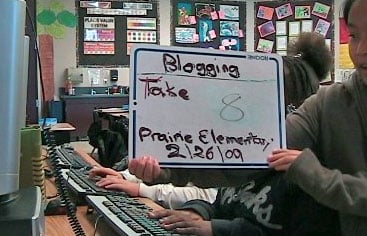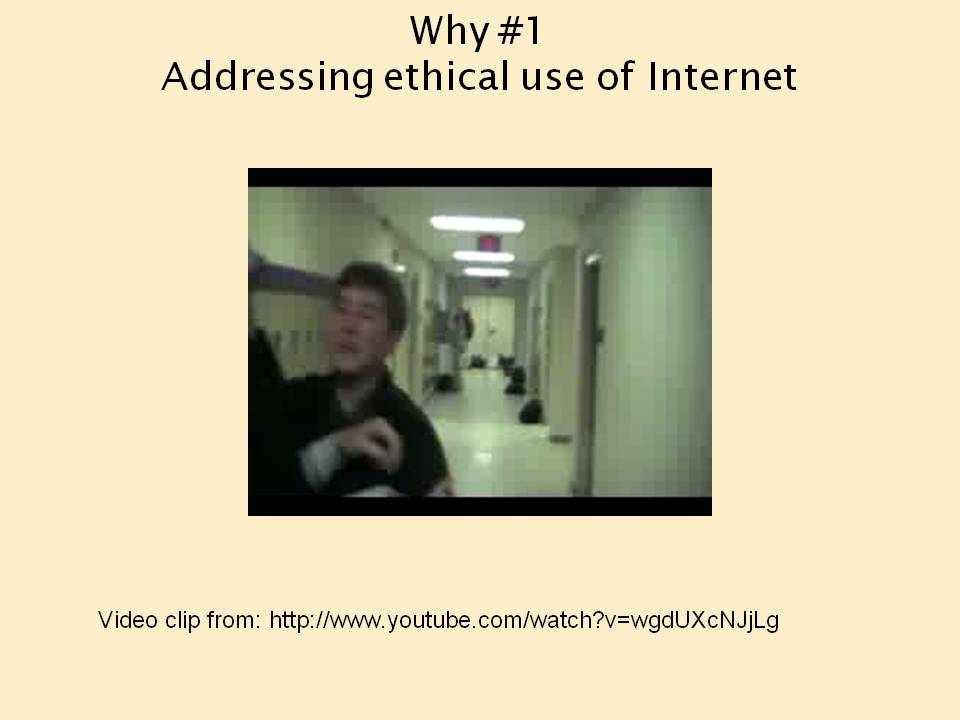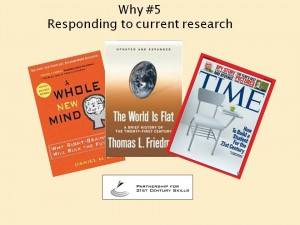The great films have not been made yet. The ones who will make them are out there, though, riding a skateboard.” – Robert Altman
 Why would a classroom teacher at any grade level or in any subject area consider adding one more activity into an already jam-packed curriculum? This is a question I ask myself repeatedly when teaching the filmmaking workshops I offer through the Area 3 Writing Project and through my school district.
Why would a classroom teacher at any grade level or in any subject area consider adding one more activity into an already jam-packed curriculum? This is a question I ask myself repeatedly when teaching the filmmaking workshops I offer through the Area 3 Writing Project and through my school district.
Last October the Sacramento Educational Cable Consortium (SECC) invited me, as part of their SEVA teacher training series, to give a workshop that would provide teachers with the justification to bring video production into the K12 curriculum. Having a workshop deadline to meet was just the motivation I needed to sit down and articulate why I believe all students should have access to filmmaking (aka digital storytelling, video production, etc.) as part of their instructional day.
I had three arguments in mind before even turning on the computer. Within an hour, I had my presentation ready to go. Three arguments expanded to six – and I was on a roll, having discovered in the process how strongly I felt about the topic.
The following week, a group of teachers willing to rise early on a Saturday filed into my SEVA workshop. I lucked out. Not only was this a very awake and participatory group, they also wanted to return to their own sites and present the case for filmmaking. Based the number of requests for my PowerPoint, SEVA organizer Doug Niva suggested uploading my slideshow to their website site.
As much as I appreciate the number of slideshows educators around the world have generously uploaded to such venues as YouTube, or SlideShare, or their blogs, I wish more content producers would also provide a written piece to document how they moved from an initial burning question or challenge to a final product or solution. What follows is my attempt to share my personal learning journey, an experience that has been shaped by first-hand interactions and observations in classrooms (mainly grades 4-12) and the research and advise of others, beginning with filmmaker Nikos Theodosakis and continuing with filmmaker and literacy coach (Los Angeles USD) Mathew Needleman and many colleagues from the National Writing Project (NWP).
So let’s return to my Case for Filmmaking in the Classroom presentation, starting with slide/argument #1:
#1: Addressing ethical use of the Internet – Picture the following scenario: an elementary teacher (yes, in my district), Googles herself. To her dismay she finds that on a day she was out, one of her students used a cell phone to film a lovely little scene of classroom chaos, to which his middle school brother later helped him flavor with some racist, homophobic words, and then upload to YouTube. As school counselors in my district scramble to deal with an explosion of cyberbullying issues, I argue that teaching the ethical use of video and the Internet must be woven into the elementary curriculum, before the onslaught of adolescent (mis)behavior.
In the case of the above siblings, the parents were clueless as to how their children were choosing to use both their cell phones and the computer in the kids’ bedroom. To illustrate the fact that too many students lack an ethical grounding in the appropriate use of the Internet, I downloaded a YouTube video of a student getting his head bashed against a locker and linked it to Slide #1.
Try doing an Internet search on “locker room fight” and you’ll get back literally hundreds of links, such as the Norwood Middle School’s claim to fame. Granted, middle school is all about making wrong decisions, but what if districts wove media education into the elementary curriculum? It is my hope that such a program could play a pivotal role in keeping students safe from each other (i.e., cyberbullying) and from themselves (i.e, sexting) and in reversing what has become an alarming trend, too often ending tragically.
#2: Promoting critical media consumption – Thanks to support from the National Writing Project, I had the opportunity to attend last summer’s NCTE Institute on 21st Century Literacies. The seed for this post was planted when Ernest Morrell took to the podium to deliver his Critical Literacy and Urban Youth: Pedagogies of Access, Dissent, and Liberation keynote address. Ernest opened with four questions that begged for discussion:
- What will be demanded of students in terms of literacy in the 21st century?
- In what ways is the nature of literacy changing?
- How should the discipline of English change in response to the changes in literacy?
- What are the ways that your students practice literacy when they are not in class?
No surprise that he answered question #4 with:
- filmmaking
- video games
- virtual worlds – adopting different identities
Slide #2 is similar to one Ernest used, maybe not the same Seventeen Magazine cover, but definitely the same image from 50 Cents, complete with its phallic symbols and suggestions of violence. I don’t know that the images from the covers of Seventeen, with the pitch, for instance, on how to Get amazing abs!, actually promote any safer or healthier life style than 50 Cents‘ collection. Given that the age range of Seventeen readers spans from 12-17, I argue that there is a critical need to provide upper elementary and middle school students with first-hand opportunities to explore and manipulate media so that they might become as skilled in reading and interpreting images as they are with decoding traditional text.
#3: Providing students with multiple ways to access core content – No matter how many times I visit CogDogRoo’s (Alan Levine) 50+ Ways to Tell a Story, each time I find new Web 2.0 resources and tools for incorporating digital storytelling across the curriculum. Whereas filmmaking was once a medium that required expensive equipment and major technical expertise, “we are at the point now where we can do some very compelling content creation with nothing more complex than a web browser.” Why would we not offer students filmmaking opportunities and options? To answer that question, I’ll call on an elementary school SEVA film producer and a middle school SEVA film producer to share their perspectives on how the process of filmmaking translates into learning venues.
A year ago, I drafted the RFP for my district’s application for Round 7 of the EETT Grant. My goal was to integrate Web 2.0 tools into the 4th grade (Year One) and 5th grade (Year Two) English/Language Arts program. In thinking back to the one-page summary that must precede the grant narrative, I remember pondering over this sentence: “Target teachers will participate in 42 hours of professional development on 21 century technologies followed by hands-on explorations with specific Web 2.0 tools (blogs, wikis, podcasts, and multimedia applications) that will ‘power up’ Open Court lessons and engage students in the learning process.” Given that every administrator will say “Yes!” when asked if he/she would like to be involved in a technology grant, often without understanding the professional development required to support teachers in adopting new tools, I hesitated to be too specific about exactly which ‘multimedia applications’ would be included, knowing that over a two-year period, new tools would emerge, adding to an already robust menu (i.e., Movie Maker2/iMovie, PhotoStory 3, VoiceThread, Animoto). But I definitely did not want the grant to be all about learning PowerPoint!
At the October EETT kickoff meeting, I noted a look of shear panic by at least four or five teachers as we started the day by connecting for an interactive videoconference with Mathew Needleman and ended the day by passing out a complete camera set (bag, tripod, microphone, two cameras) for each site. I wondered if I was being overly ambitious in my vision for taking student voices beyond the classroom via video production. But eight months later, as we approached the end of the school year and with movie making projects happening at all three EETT sites, I had the opportunity to observe students firsthand as they moved though various stages of multimedia writing. EETT teacher Tara McCartney’s commitment to providing her students with multiple modes of writing is clearly making language arts standards more attainable for her 4th graders:
#4 Supporting a collaborative learning environment – In his book The Director in the classroom: How filmmaking Inspires Learning, Nikios Theodosakis points out that “Filmmaking is a collaborative art, requiring dozens of passionate craftspeople to bring about a focused vision onto the screen. Each brings with them their own experiences and insights and makes the final film richer and truer than the director originally imagined” (p 7). Yet not all students have access to such 21st century skills as collaborating, connecting, and creating . The more high-poverty + low-performing a school site is, the greater the pressure is on administrators and teachers to deliver instruction per the ‘sit ‘n get’ model. I stand in awe of those educators who seek innovative ways to make learning engaging and memorable – despite top-down mandates that can lead to what teacher/writer Kelly Gallagher refers as “apartheid programs,” effectively denying students access to the “participatory culture” described in Henry Jenkin’s white paper.
Florin High School English teacher Bob LeVin is one of the innovators. I met Bob five years ago when I sent out an email to my district’s Technology Advisory Committee asking if anyone knew an English teacher who might be interested connecting with other classrooms in the Youth Voices online project. Bob’s enthusiastic response was the start of a yearly connection in which we meet at the start of each new school year to talk about tools and possibilities for taking his students’ voices beyond the confines of their school site and and increasingly impoverished community. What began in the first two years with a productive exploration of blogging has evolved into an annual integration of filmmaking into Bob’s program. Former student Michael Fuentes explains well the benefits of making a movie:
On the ‘same side of the tracks’ as Florin High School, Prairie Elementary School students in Lesley Mckillop’s 4th grade classroom have started the long journey to the red carpet, SEVA (Student Educational Video Awards) style. As Lesley’s young filmmakers made their way onto the stage to receive an Honorable Mention Award for Blog Safely!, I wondered if the crowd filling Sacramento’s historic Crest Theater to capacity understood what it meant to have students thanking their principal for driving them to the awards ceremony. Lesley, an innovator and an EETT teacher, came to me following the October kickoff and shared that she knew nothing about technology. Her initial reaction to bringing filmmaking to her 4th graders was the feeling of being completely overwhelmed while at the same time wanting to get on board and, more importantly, bring her class on board. By the time the school year drew to a close, all of her students had participated in the making of one or more movie productions, and for a handful, including the young man who is the last to step up to the microphone in the clip I’ve inserted at the end of this post, filmmaking has rocked their worlds.
# 5 Responding to current research – During the October SEVA workshop, I shared some snippets from Daniel Pink‘s A Whole New Mind and Thomas Friedman‘s The World Is Flat, passed around my Time Magazine issue, and promoted the work of the Partnership for 21st Century Skills – all of which point to the many “c” words associated with new literacies, such as connecting, collaborating, and creating .
In April, I traveled down the road to Berkeley for a NWP Digital Is meeting, where I had the good fortune to meet Liz Stephens. As an opening activity, the meeting coordinators asked our cozy group of 12 to think about and share a “whack on the head” about the intersection between writing and technology. Liz’s statement that writing in a digital age is “more about ‘frames’ than ‘stages’ was an instant jolt for me and brought to mind recent conversations with teachers and students, such as Xavier Carillo (former student of Bob LeVin), who shares a “no duh”:
In a test-driven climate, it’s easy for teachers and administrators to view filmmaking as a ‘when-testing-is-over’ activity. I think if they could sit in on a session or two with students from my EETT classrooms, they would see that, unlike worksheets, as students delve into their filmmaking projects, a major shift happens. They typically begin a project with the idea of “completing an assignment.” And then the shift happens: they see themselves as producers of content that others will see and benefit from. They have – with much enthusiasm and pride – ascended to the top level of Bloom’s Taxonomy (as revised in 2001 by Anderson and Krothwahl).
#6 Engaging students -Well this one is pretty much a no brainer. No matter what their access is during or beyond the school day, students like technology. From brainstorming, to storyboarding, to filming, to narrating, to editing – many students find a niche in the filmmaking process that pushes them as learners, as contributors, as team players. As they shift from consumers to content producers, there is also a shift in ownership of the learning. Step into their classrooms, and you will see the collaborative efforts start to happen, you will feel the synergy, and you will witness new levels of student engagement.
It’s been my privilege over the past few years to watch colleague (same district, same Writing Project) Jim Faires weave filmmaking into his 6th grade curriculum at Butler Elementary School. Through filmmaking, Jim is often on the receiving end of inspiration.
But how does a teacher justify integrating filmmaking in a textbook and test-prep driven school day? In my state, California Standards for the Teaching Profession provide a ready-made argument. Checkout the first standard: ENGAGING AND SUPPORTING ALL STUDENTS IN LEARNING:
Teachers build on students’ prior knowledge, life experience, and interests to achieve learning goals for all students. Teachers use a variety of instructional strategies and resources that respond to students’ diverse needs. Teachers facilitate challenging learning experiences for all students in environments that promote autonomy, interaction and choice. Teachers actively engage all students in problem solving and critical thinking within and across subject matter areas. Concepts and skills are taught in ways that encourage students to apply them in real-life contexts that make subject matter meaningful. Teachers assist all students to become self-directed learners who are able to demonstrate, articulate, and evaluate what they learn.“
Back to my initial question: How does a teacher find the time to integrate one more activity into the school day? Take three minutes to watch Lesley McKillop’s students as they ‘walk the red carpet.’ At the end of the this on-the-spot video, shot collectively (without a tripod) by her students, Lesley provides an answer to that important and often-asked question.
The Case for Filmmaking in the Classroom from Gail Desler on Vimeo.
I actually started this post several months ago but didn’t publish it, thinking there were probably more points and definitely more resources that I could add. I’ve recently rediscovered, for instance, Edutopia’s What Works in Public Education site. A search on ‘filmmaking the classroom’ brought up a list of great articles – more than enough to justify my hitting the Publish button. If you have ideas and/or resources to add, I invite you to join me in this conversation and post a comment. I’m pretty sure my six arguments could easily be expanded to a dozen or more!




Pingback: Next Stop…20th Century | BlogWalker